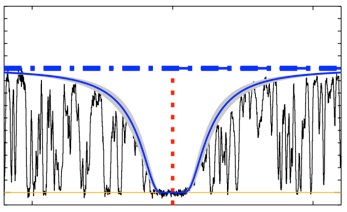Metallicity Evolution of Damped Lyman
Alpha Systems out to z~5

Metallicity Evolution of Damped Lyman
Alpha Systems out to z~5
We present chemical abundance measurements for 30 damped Ly-alpha systems (DLAs) at z > 4, and another 18 at z > 2.4, observed with the Echellette Spectrograph and Imager and the High Resolution Echelle Spectrometer on the Keck telescopes. We measure H I column densities of the DLAs with Voigt profile fits to the Ly-alpha profiles, and determine ionic column densities using the apparent optical depth method. We combine our new metallicity measurements with those from past surveys to determine the evolution of the cosmic metallicity of neutral gas. We find a continued decrease in the metallicity of DLAs with increasing redshift, improving the significance of the trend and extending it to higher redshifts, with a linear best fit of −0.21±0.04 dex per unit redshift. The metallicity “floor” of ≈ 1/600 solar continues out to z ∼ 5, despite our sensitivity for finding DLAs with much lower metallicities. Additionally, the dispersion in metallicities of ∼ 0.5 dex continues out to z ∼ 5, and is due to intrinsic scatter amongst the DLAs. These observations of the metallicity evolution tightly constrain the star formation history of z ∼ 5 galaxies and the processes that transport metals from star-forming regions to the ambient ISM. In addition, we find that the metallicity distribution and the alpha/Fe ratios of z > 2 DLAs are not inconsistent with those of halo stars. This is the first time that any known population of stars have been shown to not have inconsistent metallicity distributions with DLAs. It is therefore possible that the halo stars in the Milky Way formed out of DLA gas.
Ph.D. work conducted at the University of California, San Diego with Prof. Arthur Wolfe and at IPAC at Caltech




